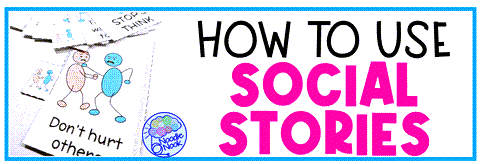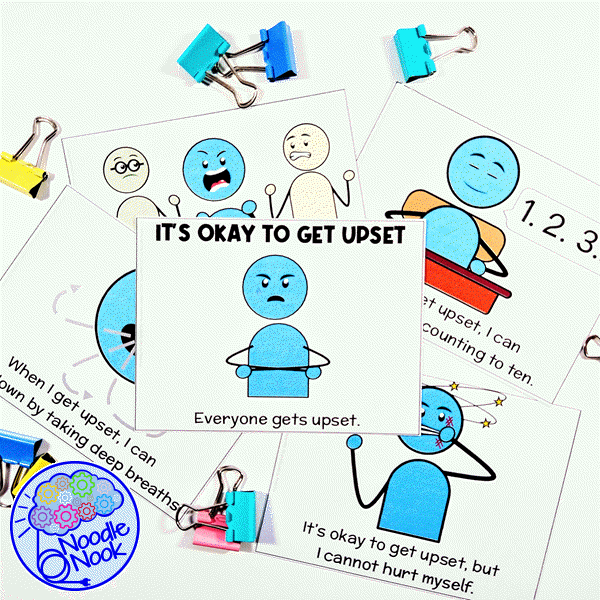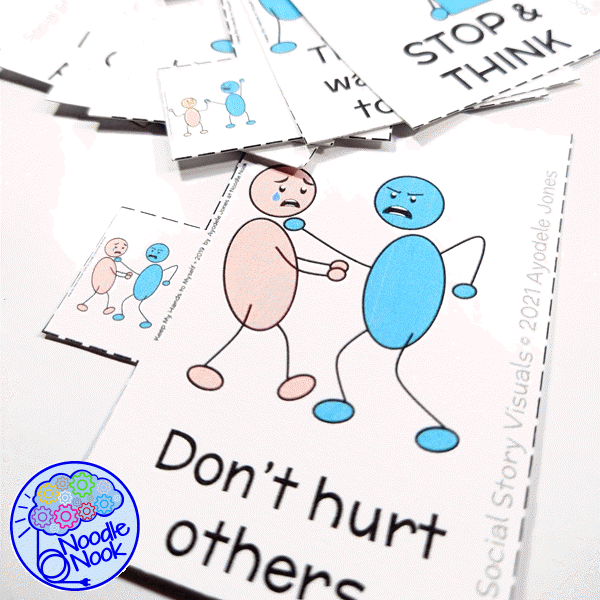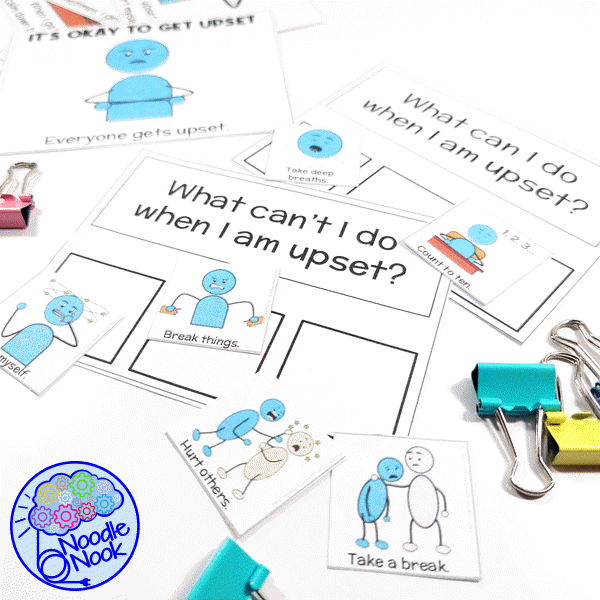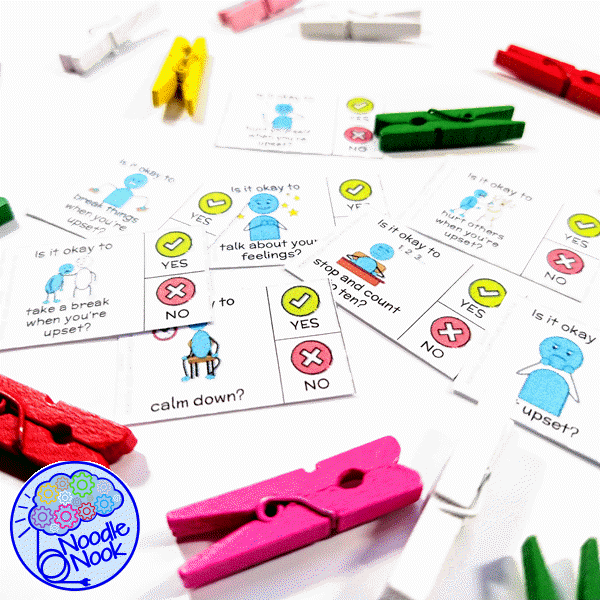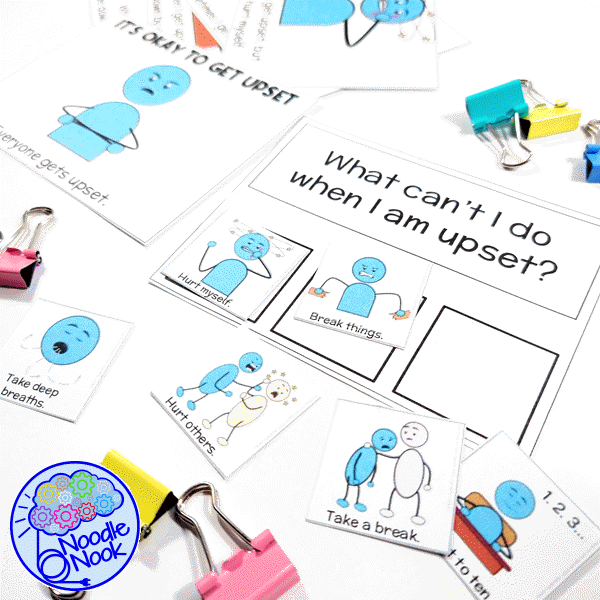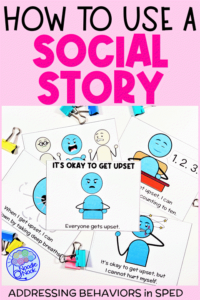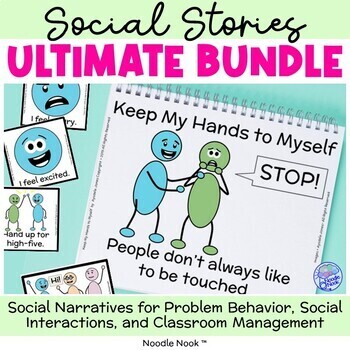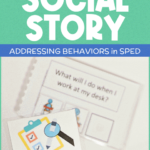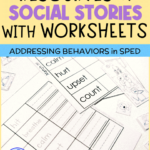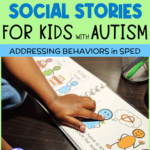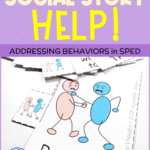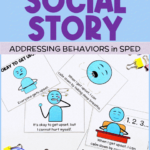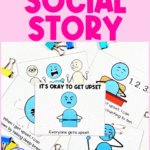Social stories are an essential resource in the special education classroom as a tool to help students better understand social situations and also use socially appropriate behavior. This is everything you need to know on how to use a social story in special education along with some helpful resources, including some FREE social narratives!
What is a Social Story?
A social narrative or story is a short story that addresses a target skill or behavior. It explains when a target strategy is used as well as the positive outcomes that will occur when a student uses the strategy or replacement behavior appropriately. It also outlines why a student would want to use the target strategy or behavior, namely to avoid negative consequences.
When a social story is written correctly, it uses visuals and concrete language to explain a specific set of rules and expectations a child needs to follow. If you use a social story effectively, you can change a child’s behavior for the better but, more importantly, you can teach them how to solve problems and deal with different situations in a way that is prosocial and neurotypical.
How Do Social Stories Help?
Why should you use a social story? It’s simple.
Using social narratives improves the quality of life for a student with a disability by allowing them to build better and stronger interpersonal relationships.
Social stories also make students more employable. This gives them a better chance of living independently. Independence is huge and a major goal in the world of special education. We want our students to be as independent as possible.
Finally, at the very least, using a social story will minimize the negative behaviors in your classroom. That’ll give you more time to address academics, take data, and do IEP paperwork. You know, all that teacher-y stuff.
Basically, using social stories is a teacher & student win!
How Do You Use a Social Story?
STEP 1: TARGET something SPECIFIC
Using a social story means you are targeting a specific outcome. There is a particular situation where a student needs to increase their social competence OR there is a target behavior that you want to replace with a more preferred behavior. Either way, step one is to make sure you are targeting something specific.
Refer to the student’s IEP for social skills deficits or use classroom observations to determine specific behaviors that need to be addressed.
When choosing what to address, consider asking your teaching team, parents, and outside therapists on their opinion. You’ll want to all come to a consensus as to which behavior needs to be addressed first.
Plan on targeting ONE behavior at a time. You’re not going to be reading 6 or 7 social stories at once. Be purposeful.
STEP 2: INTRODUCE the STORY
Tell the student you are going to read a story together. Read the title. Ask the student to point to it or engage with the book in some way.
Before you read, make some connections between the student and the book based on the title, subject, or images on the cover. We want to establish early that this story is connected to them or about them.
As an aside, read a social story when a student is in a calm and open state. The time to read through the story isn’t when they’ve just had a meltdown, are still sobbing, and hate everyone and everything. That is the WORST time. Choose your instructional time wisely.
Read More: Social Stories for Kids with Autism, Social Stories in LIFE Skills
STEP 3: READ the STORY
As you get ready to read the story for the first time, you will have to know the tolerance and attention span of your student.
If their attention span is small, then plan on reading through the story without a lot of extra pauses to talk, checks for comprehension, or additional interactions. You just wanna get through it.
If their attention span is a little longer, then pause to ask questions, have the student repeat back to you some of the main ideas or strategies, and engage in some reflection with comments like “that’s what I would do in this situation” or “I like how they are solving their problem”.
If possible, especially if your student is nonverbal or minimally verbal, ask for them to point or engage in the book visuals to ensure they are understanding and paying attention.
STEP 4: REVIEW and REREAD
Set a schedule so that you’ll come back and review the story regularly. You want to reread it will that same self-talk, reflection, and checks for comprehension that you did in the first read-through. We are looking to reinforce the narrative for the student.
If your narrative included specific words or phrases a student should use, then have them state those phrases or words. If they are supposed to use a certain gesture or behavior, have them practice it.
STEP 5: PRACTICE in CONTEXT
It’s one thing to read about a behavior or strategy… it is quite another to actually execute it.
As much as I love to read recipes and watch cooking shows, I still burn water.
After you’ve reviewed the story repeatedly, it’s time to walk the walk. Put the student into the target situation, model the behavior, and then have them practice the behavior or skill.
I really love having support visuals here that I can take into the environment to cue the student to say specific things or behave in alignment with the story. It makes it a little easier to up and go. It also allows me to have a portable tool when negative behaviors are likely to happen.
No matter the behavior, try to set up a practice situation, role-playing activity, or rehearsal for when the real thing happens. We need practice.
STEP 6: GENERALIZE to Other SITUATIONS
Now that we’ve practiced, we want to apply the skill to similar situations. This may not be an appropriate step for ALL social stories. A social story about not hitting may be generalized to not kicking… but a social story about not picking your nose may not have a generalizable skill.
What is important here is that the student has a clear understanding on when and how to use the strategy or behavior you’ve been working on.
Social Stories, Worksheets, and Teaching Resources
Now that you know how to use a social story and how social stories help, let’s talk about some social stories for kids with autism and examples of helpful social stories.
Free Social Stories for kids with Autism
I love FREE! Who doesn’t? You can get lots of free social stories for kids with autism, but that doesn’t mean they are great. It takes some digging to find the good ones.

Here is a great one from And Next Comes L.
They have loads of great resources for teachers. Check out this one on fidgeting.
Able to Learn has a bajillion social stories for free.
Lots of them target skills that are super specific to students with significant disabilities, like ‘I Can Poop in the Toilet’.
That’s a total winner (and I mean that seriously). Check it out.

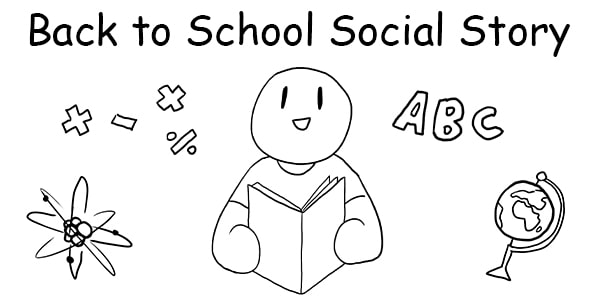
One more great set of stories comes from National Autism Resources. There is an entire free social story library, including this one which is perfect for any student going back to school. Check it out.
Printable Social Story and Teaching Resources
For me and my students, a 10-page social story was never enough to reinforce skills and keep things fresh. I needed worksheets, visuals, and some comprehension checks that worked for non-verbal students. That is where some printable social stories that include worksheets and activities make more sense.
Check out the Ultimate Printable Social Story Bundle from Noodle Nook. Just what you need to start using social stories for behavior and social skill building.
These narratives come with comprehension activities, behavior visuals, writing activities, role playing supports and more. CLICK HERE to see them in action.
Making a Social Story Book
If you are in the process of making a social story kit for your classroom, I suggest taking the Ultimate Social Story Bundle and getting to the task of printing and prepping them.
YO! We are Amazon affiliates.
The links below will take you to Amazon and, if you purchase through these links, we get a few pennies which we use to keep this great content coming at you. Kidding. We totally use it all to buy more lamination and Velcro! #SpEdTeacherLife
Either way, thanks for the support!
In order to work all your teacher magic, you’ll need:
- Color Printer. I love this tankless kind, great prints and super speedy!
- Lamination Sheets. Pouches are the key to longevity!
- Laminator. If you don’t already have one, it’s the best money you’ll spend this year.
- Paper Cutter. I just love when the lines are straight!
- Binding Machine. Putting it all together and keeping it all together.
- Binding Combs. Better than staples.
- Hook and Loop Dots. Ummm… Velcro is my jam. It keeps me together.
Once you have all these resources (consider putting them on an Amazon wish list), get to the job of printing, laminating and binding.
Start with the book by printing and laminating. Then you’ll print the comprehension checks, laminate, and add Velcro,
You can either attach the comprehension check to the book OR keep them separate. Once you’ve decided, put it all together and coil.
Yay! Teacher Magic!
Don’t forget to rev up that new laminator with the Ultimate Social Story Bundle from Noodle Nook.

